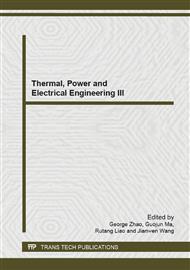[1]
C. Taylor, Reactive power compensation and voltage stability: removing transmission limitations, Seminar Book, February (1997).
Google Scholar
[2]
P. Kundur, Power System Stability and Control: McGraw-Hill, ( 1994).
Google Scholar
[3]
P. M. Anderson , A. A. Fouad, Power System Control and Stability, IEEE Press, ( 1994).
Google Scholar
[4]
V. Ajjarapu, B. Lee, Bibliography on voltage stability, IEEE Trans. Power Systems, vol. 13(1), pp.115-125 (1998).
DOI: 10.1109/59.651622
Google Scholar
[5]
J. R. Shin, B. S. Kim, M. S. Chae, and S. A. Sebo, Improvement of the precise P-V curve considering the effects of voltage dependent load models and transmission losses for voltage stability analysis, " Proc Inst. Elect. Eng., Gen., Transm., Dist., vol. 149(4), p.384.
DOI: 10.1049/ip-gtd:20020258
Google Scholar
[6]
V. Akhmatov, Variable-speed wind turbines with DFIG. Part IV: Wind Energy, vol(27), p.519–529 (2003).
DOI: 10.1260/030952403773617481
Google Scholar
[7]
S. Muller, M. Deicke, , R. W. De Doncker, Doubly fed induction generator systems for wind turbines, IEEE Ind. Appl. Mag, vol. 8(3), p.26–33 (2002).
DOI: 10.1109/2943.999610
Google Scholar
[8]
Y. Lei, A. Mullane, G. Lightbody, R. Yacamini, Modeling of the Wind Turbine with a DFIG for Grid Integration Studies, IEEE Trans. Energy Conversion, vol. 21, n. 1, p.257 – 264(2006).
DOI: 10.1109/tec.2005.847958
Google Scholar
[9]
W . Leonard, Field oriented control of a variable speed alternator connected to the constant frequency line, Proceedings of the IEEE Conf on control of power system, , pp.149-153(1979).
Google Scholar
[10]
M. Yamamoto , O. Motoyoshi, Active and reactive power control for doubly-fed wound rotor induction generator", IEEE Trans. Power Electron., vol. 6, n. 4, Oct. 1991, p.624–629.
DOI: 10.1109/63.97761
Google Scholar
[11]
R. Pena, J.C. Clare, G.M. Ashek , Doubly-fed induction generator using back-to-back PWM converters and its application to variable-speed wind-energy generation, Electric Power Applications , IEE Proceedings, vol. 143, (3) , pp.231-241(1996).
DOI: 10.1049/ip-epa:19960288
Google Scholar
[12]
F. Poitiers, M. Machmoum, R. L. Doeuff, M. E. Zaim, Control of a DFIG for wind energy conversion systems, Inte Jour Rene Energy Eng, p.373–378( 2001).
Google Scholar
[13]
A. Naamane, N.K. Msirdi, Doubly-fed induction generator control for an urban wind turbine, International Renewable Energy Congress , Sousse, Tunisia Nov( 2010).
Google Scholar
[14]
Z. Boudjema, A. Meroufel , E. Bounadja, Robust Control Improvement of a Doubly Fed Induction Generator for Wind Energy Conversion, 4th Int Conf ICEE, Algiers (2012).
DOI: 10.1016/j.egypro.2014.06.119
Google Scholar
[15]
A. GAILLARD : Système éolien basé sur une MADA : contribution à l'étude de la qualité de l'énergie électrique, Ph.D. dissertation University Henri Poincaré, Nancy, (2010).
Google Scholar


